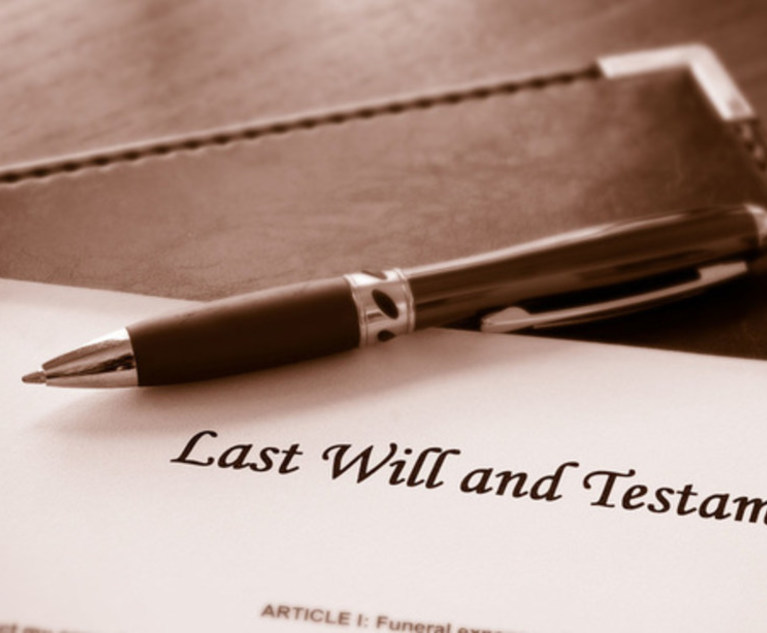C Raymond Radigan

July 01, 2022 | New York Law Journal
How Final Is a Decree Based Upon Virtual Representation?While we often see virtual representation provisions contained in wills and trust instruments, the absence of such a provision is not fatal to the application of the doctrine of virtual representation.
By C. Raymond Radigan and David N. Milner
9 minute read

December 30, 2021 | New York Law Journal
Accounting for Fiduciaries' ActionsAs with all other fiduciary duties, accounting is an integral part of being a fiduciary of an estate or trust, and must be handled with due care to protect both the fiduciary and the beneficiaries.
By C. Raymond Radigan and Lisa Fenech
6 minute read

October 29, 2021 | New York Law Journal
Asserting Affirmative Defenses to Objections in Accounting ProceedingsSuffice it to say that something as simple as raising affirmative defenses has complexities not found in Supreme Court practice. This is especially true in accounting proceedings, the procedural vehicle where parties often litigate a whole panoply of claims.
By C. Raymond Radigan and John G. Farinacci
9 minute read

April 30, 2021 | New York Law Journal
Now, More Than Ever, New York Needs a Directed Trust StatuteWhile the creation of trusts may have significant tax savings, many clients remain concerned about giving up control to one trustee. Directed trusts have become increasingly popular with clients for precisely this reason. In this edition of their Trusts and Estates Law column, C. Raymond Radigan and Jennifer F. Hillman discuss this type of trust and analyze the current state of the law in New York pertaining to it.
By C. Raymond Radigan and Jennifer F. Hillman
8 minute read

December 30, 2020 | New York Law Journal
Wrongful Death Compromises: A ProposalIn this Trusts and Estates Law column, C. Raymond Radigan and Lisa Fenech write: The systems by which wrongful death actions are commenced, and settled, are integral to the proper reimbursement to families for their loss. As a statutory mechanism for recovery, the procedures followed must be uniform to enable consistent recovery and allocation of funds. The incorporation of SCPA §702(1) restrictions on all Letters would ensure reliability for decedent's families and the courts in these matters.
By C. Raymond Radigan and Lisa Fenech
7 minute read

September 11, 2020 | New York Law Journal
My Kidney to Yours: The Organ Shortage CrisisIn this Trusts and Estates law column, C. Raymond Radigan and Lisa Fenech discuss the steady demand for donated organs and the declining supply.
By C. Raymond Radigan and Lisa Fenech
6 minute read

January 03, 2020 | New York Law Journal
The Future of Mediation in Trusts and EstatesIn this Trusts and Estates law column, C. Raymond Radigan and Lisa Fenech discuss a new mediation initiative that is helping to resolve the logjam within the courts. Practitioners should be aware of this plan, and the ways it may help their clients resolve family disputes in a more efficient manner.
By C. Raymond Radigan and Lisa Fenech
6 minute read

November 21, 2019 | New York Law Journal
Thoughts on Court Consolidation: The Surrogate's CourtToday, the Surrogate's Court is a Constitutional Court and is not a creature of the legislature. It was created by the people and, therefore, it would require a constitutional amendment to change that court.
By C. Raymond Radigan
10 minute read

September 06, 2019 | New York Law Journal
Anatomy of a Probate Contest, Part 4: Objections to Probate and Discovery in a Probate ProceedingTrusts and Estates Law columnists C. Raymond Radigan and Lois Bladykas discuss the filing of objections to probate, and explores discovery issues that may arise during a contested probate proceeding.
By C. Raymond Radigan and Lois Bladykas
6 minute read

July 03, 2019 | New York Law Journal
Anatomy of a Probate Contest, Part 3: SCPA 1404 ExaminationsIn their Trusts and Estates Law column, C. Raymond Radigan and Jennifer F. Hillman provide some practical insights into the SCPA 1404 process and procedure.
By C. Raymond Radigan and Jennifer F. Hillman
8 minute read
Trending Stories
- 1The Law Firm Disrupted: Playing the Talent Game to Win
- 2A&O Shearman Adopts 3-Level Lockstep Pay Model Amid Shift to All-Equity Partnership
- 3Preparing Your Law Firm for 2025: Smart Ways to Embrace AI & Other Technologies
- 4BD Settles Thousands of Bard Hernia Mesh Lawsuits
- 5A RICO Surge Is Underway: Here's How the Allstate Push Might Play Out
More from ALM
- Morgan & Morgan Class Action Attorneys Detail Pathway to Success Within Cybersecurity and Data Privacy Practice 1 minute read
- Holwell Shuster & Goldberg Partners Leverage 'Hostile' Witnesses to Secure $101 Million Verdict Against Walmart 1 minute read
- Legal Speak at General Counsel Conference Midwest 2024: Mike Andolina, Partner, White & Case 1 minute read



